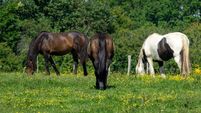Farmers use the mouse to search for not-so-virtual bullocks


Great news. Bernie Ecclestone is to become a father at 89!
The energetic octogenarian and former Formula One tycoon will welcome his first son in July, with his 44-year-old wife Fabiana.
Despite this making him one of the oldest known new fathers, Bernie remains unfazed by the whole thing saying “I don’t see there is any difference between being 89 and 29. You have got the same problems.”
Well, Bernie, you’re talking through your hat in that regard. I’m not yet 50 and my problems today far outweigh any frivolous anxieties I had in my late 20s.
Anyhow, Bernie and his wife of seven years are currently self-isolating on their ranch near Sao Paulo, Brazil.
Which, I expect, for a man worth about a zillion, is like self-isolating in the Ritz.
I doubt if they are running out of milk, sugar, and toilet paper.
Anyhow, best of luck, Bernie.
So, back to reality we go, or is it?
Ireland’s first virtual cattle mart
Because of coronavirus, our beloved cattle marts are no longer reality, they have this week gone virtual!
What would people like the late legendary cattle auctioneer Jack McGraw make of it all?
They would probably ask “What the devil is virtual? And how did the likes of you get a job on the newspaper?”
Well, on the subject of virtual marts, they’d be asking the right man.
For I can tell you all you need to know about the latest craze in cattle selling, or at least all I know about it at this stage.
Purchasing cattle may never be the same again.
On Monday, April 6, 2020, Ireland’s first virtual cattle sale took place in Carnaross mart in Co Meath.
I spoke to Padraig McElroy, manager of Carnaross Mart, on Tuesday evening about the historic sale.
He took all the history making in his stride, and said they were very pleased with how the virtual mart had gone ahead.
More importantly, they were very pleased with the sale of cattle. Business is business, after all.
“We had a 98% clearance with stock mostly between 300kg and 800kg.
“The sale went better than we had hoped, with up to 3,000 people viewing online at one stage.”
Yearling heifers at the sale made up to €2.10 a kilo, with good quality 500 kilo continental store bullocks making €2.40 per kilo.
Just over 200 cattle were sold at Carnaross Mart on Monday.
With webcams installed in the ring, and online bidding via mobile phone and PC, it was reported that only six people were at the mart, with a huge attendance tuning in, virtual style.
The first thing that has to be said about going to the mart virtually, is that you don’t have to go at all!
You can go to the mart while still in bed, in your pyjamas in fact.
All you need is a computer or a modern mobile phone, which most people have today.
Carnaross - Monday
- 1 AA steer 550kg 1070
- 1 Ch steer 500kg 1190
- 1 Hr steer 320kg 670
- 1 Lm steer 705kg 1330
- 1 Sim heifer 570kg 1227
- 1 AA heifer 300kg 660
- 1 Ch heifer 475kg 1040
The next thing you need to do is log onto livestock-live.com, which is the home of the virtual mart.
A mart without a smell, a mart without an atmosphere. But most importantly today, a mart that is functioning.
A mart where cattle can be sold and purchased.
Carnaross Mart on Monday, while practically devoid of people, was perhaps one of the most watched cattle sales in history of Irish cattle trading.
The sale was streamed online with bidders able to look up stock before the sale and bid on livestock using an app when the sale got under way.
Cattle appeared in the ring as normal, with the auctioneer in his rightful place.
Only this time, instead of looking around the ringside for winks, nods, scratching of the ear, tugs of the collar, a wiggle of the toe, flicks of a finger, or wave of a hand, his attention was taken by bids coming from the wonderful world of the internet.
To register a bid, you needed in the first instance to log into the system.
This can be done by giving your herd number and other details. It’s no big task, even I was able to do it eventually.
And with that, you’re away.
This week, compliments of livestock-live.com and the virtual world, calves were averaging €124 a head.
Weanling bulls averaged €1.99/kg, weanling heifers €2.13/kg.
Looking at larger animals, Friesian cows suitable for dairying averaged €1,560 a head.
Friesian bullocks suitable for the likes of myself averaged €1.65/kg.
Aberdeen Angus bullocks were making in and around €1.88/kg.
Limousin bullocks averaged €2.29/kg, with Charolais bullocks making in the region of €2.06/kg.
Heifers averaged €2.04/kg.
While the cattle may appear in the virtual world, the money demanded at the end of the day to take them home must still be the real stuff.
Virtual mart versus traditional mart
While it may be only a few short weeks ago that we all crowded into a mart ring to sell, buy and witness a cattle sale, it now seems such a long time ago.
Covid-19 has changed everything.
Temporarily at least, but who knows?
This week sees the beginning of a new era of cattle trading here in Ireland.
Virtual marts are no longer a figment of the imagination, they have become a reality.
And like all things that stem from ‘necessity being the mother of invention,’ it could well become the norm.
With marts virtually closed (forgive the pun), farmers have been left with little option but to use the mouse when in search of bullock.
For many in the cattle business (myself included), the world of the computer still seems alien.
But we can be fast learners when we need to be, and for a new generation of computer-savvy farmers, the demise of the mart as we know it could be a lost closer than we think.
The last time the marts closed their doors for a long duration was during the Foot and Mouth crisis of 2001. And when they closed, they closed.
Times were different back then. Technology was different, hell, we were all different. There have been a lot of advances in between.
And while internet speeds might still seem slow in many areas, we are now miles ahead of where we used to be.
The fact is, virtual marts are a reality, and it’s now just a matter of seeing how accepted they are in farming.
Speaking to two younger farmers on Tuesday evening about the sale, one said: “We live in a technological age, most of this generation will have no trouble buying cattle this way, and the older generation won’t be too long in picking things up.”
The other, referring to calf purchasing at a virtual mart sale, said: “How are you supposed to check a calf online, to see if he has scour, or examine his navel to see that it isn’t swollen?”
Call me old fashioned if you like, I’ve been called a lot worse.
But I still prefer to see an animal in the flesh before raising the hand.
A bit like a horse trader, where movement in the animal is king, there is nothing like seeing the animal in the here and now.
I personally doubt if cattle trading will ever sit comfortably on a desk in the virtual world.
But with the Covid-19 threat still haunting our every move, we have been left with little option but to move indoors and online.
I believe that once the threat has passed our marts will return as before.
For while the traditional mart facilitates us all in the trading of livestock, it also does a great service in boosting and sustaining farming morale.
There is a pleasure and camaraderie that can be found in the marts that no virtual world will ever replace.










